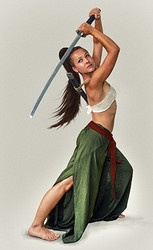Samurai Swords – Some Interesting Facts about the Katana
28th Jan 2019
The katana was one of the two Samurai swords carried by the Japanese warrior. The combination of the two blades was called daisho (“big-little”) and also featured the smaller wakizashi.
This blog reveals some interesting facts about bigger and more popular katana.
1. Samurai warrior and his sword
In movies and pop culture, the relationship between the Samurai warrior and his sword is sometimes depicted as a deep spiritual bond. While that may be true, the wider consensus is that the sword was nothing more than just a very important tool of war. Also, spears and bows were the soldier’s primary weapons in the battlefield. Of course, the katana had its value in war, especially in close combat where the aforementioned weapons were of little use.
2. Sword-making was a serious undertaking
Making a Samurai sword required serious dedication. For sword smiths, it was much more than just turning up to a smithy and forging a blade. Traditional katana makers purified themselves before even beginning the forging process. They did this by abstaining from sexual activities, fasting, and reciting prayers under a waterfall. This kind of reverence was practiced throughout the sword-making process.
3. The first Samurai swords were not curved
The first Samurai soldiers may have used a straight blade imported from Korea and China. The curved blade that we associate with the katana today came much later, after the Samurai recognized the value of such a design while attacking from horseback.
4. Other parts of the katana were valuable too
The blade was the most important part of the Samurai sword. However, other parts also determined its value. The tsuba (hand guard) was sometimes considered just as valuable as the blade. Also, there were designated specialists for mounts and scabbards and the combination of their varied skills gave the katana its eventual worth.
5. Katanas were used in World War II
The Meiji Reformation in the 19th century changed the way the Japanese viewed war weapons. The Emperor was a big advocate of firearms and so Samurai swords were slowly phased out. However, it is interesting to note that katanas were still used during World War II.
6. Samurai swords were banned after World War II
Samurai swords were banned in the period 1945–53, thus effectively ending mass production. Once the ban lifted, only certified sword smiths could make them. Today, Japanese sword smiths must undertake a lengthy apprenticeship before they are allowed to forge the katana. The number of swords that they can make per year is also regulated.
7. Japanese citizens have a right to own the katana
Citizens can own katanas registered with the Japanese Sword Association, as long as the sword has historical or cultural significance. To legally own a katana, one must possess a certificate of authenticity and ownership permit.
Check out our amazing range of Asian and Japanese swords.


 Gift Cards
Gift Cards